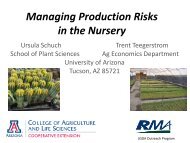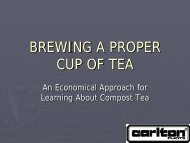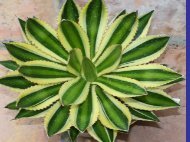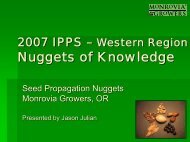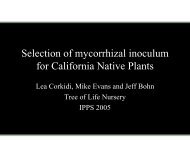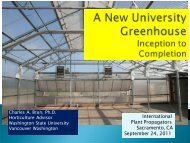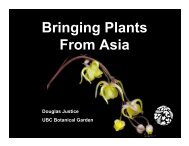Cycad germination
Cycad germination
Cycad germination
- No tags were found...
You also want an ePaper? Increase the reach of your titles
YUMPU automatically turns print PDFs into web optimized ePapers that Google loves.
By Eric T. Anderson
To germinate place <strong>Cycad</strong> seeds on a light well drained soil mix. Lay the seedson top of Course sand, horticultural perlite or sponge rock in humid greenhouseconditions for the best results. Bottom heat at 80* F speeds up <strong>germination</strong>.When the root is about one inch long the seedling should be potted up in a onegallon container. Be sure not use to use a soil mix with peat moss for theAustralian cycads.
Seed Cones of E. tegulaneus
This group of living fossils produces some of the mostinteresting and brightly colored seed cones. The key togood <strong>germination</strong> of <strong>Cycad</strong>s starts with successfulpollination. <strong>Cycad</strong>s are dioecous producing eitherpollen cones or seeds cones. There are eleven genera of<strong>Cycad</strong>s and each group can be grouped on how topollinate and germinate. In nature most cycads areinsect pollinated and wild seed generally has higherviability than artificially pollinated cultivated plants.Once pollinated the seed develops in the seed cone forseveral months to two years with the average seed conematuring at 8 to 9 months.
Pollen Cone of Encephalartosgratus
In cultivation the <strong>Cycad</strong>s lack the natural pollinators and so theymust be pollinated to produce viable seeds. The first step iscollecting pollen. The pollen cone when fully developed willrelease the pollen from capsules. The easiest test is to tap thecone and watch for pollen to fall. Please take precautions not tobreathe the pollen. Especially the Australian <strong>Cycad</strong> species assome of the scientist who have were heavily exposed developedsevere health issues thought to be a result of exposure to <strong>Cycad</strong>pollen. Then remove the pollen cone from the plant and lay onsmooth paper and then pollen is easily collected. With <strong>Cycad</strong>which is the most primitive of the <strong>Cycad</strong>s you can simply dust areceptive seed cone which is made up of modified leaves with theovules attached directly. All the rest of the genera produce a truecone which is harder to figure out when they are receptive andhow to deliver the pollen. The pollen must get to a micropyle of areceptive female ovule. When receptive a small drop of liquid ispresent and the pollen must get to this liquid for pollination tooccur. As the liquid dries it pulls the pollen into the seed.Fertilization will usually take place several months later.
Cycas thoursii seed cone
Fresh pollen is the best but not alwaysavailable. Fresh pollen will lose its viabilitywithin a few months. Pollen can be storedby drying and then freezing for up to threeyears. The pollen can then be applied to areceptive seed cone either dry or wet.Shortly after the seed cone fully emerges itwill loosen up in some way while they arereceptive, which is usually for only a fewdays. With the seed cones the easiest way todeliver the pollen is to remove the top andblow or pour the pollen in. The Dioon conesare different as they open from the base andin nature the insects climb in and deliver thepollen into the cone. It is tricky to figure outwhen this is occurring.
After pollination or few days after being receptive theseed cones close up and the seed will develop. In mostof the genera if the pollination is not successful theseed will not produce full sized seeds except theEncephalartos. They will produce seed which appearsnormal but is not viable. The method to tell if yourpollination has been successful is cutting the seed andlook for a coiled suspensor and embryo. However withsome <strong>Cycad</strong>s this is difficult to really see. Agerminating seed is the only way to really tell ifpollination was successful.
Seed coneEncephalartos KisamboFull sized fruit, notpollinated.
Bowenia- seeds germinate quickly and are ready toplant when the seed cone falls apart. Chigua- Is a tropical genus that is very rare and mostclosely related to Zamia. Lepidozamia- The seed cones are large and can weighup over 60 lbs with over 300 seeds inside. Store theseed for a few months after the seed cone matures toallow the embryo to develop and then plant for best<strong>germination</strong>. The pollen cones have a dramatic way ofshedding the pollen.
Ceratozamia- The most common cultivated species isC. Hilda and the easiest to have a high rate ofsuccessful fertilization. The time of day and themethod of pollination (wet or dry) are critical and theseeds are fully developed and ready to plantimmediately when the seed cone falls apart. The otherspecies are more difficult with a low fertilization rateusually the result.
Cycas- Most have distinctclosed cones like Cycasrevoluta, with a second groupthat is open and loose wherethe seeds are alwaysexposed. The open coneseeds are larger and oftenhave a spongy layer thatcauses the seeds to float.After the Cycas seed ismature most of the speciesdo best if you store the seedsfor 3-5 months to allow theembryo to develop morebefore sowing.
Encephalartos- Will produce full sized seeds even if not pollinated. Floatingthe seeds is not a reliable indicator of viability. Most species require four tosix months of storage to get the best results. A few species ofEncephalartos are fully mature when the cones fall apart and are ready toplant immediately.
Macrozamia moorei Seed coneMacrozamia- The seedcone develops quicklyand it is difficult to figureout when it is time topollinate, however if thepollen is applied at theright time the fertilizationrate can be very high.The seeds should bestored for 2-4 monthsbefore sowing.
Microcycas- Produces a bad smell when both the male andfemale cones are receptive. The seed is fully mature andready to sow when the seed cone disintegrates. The FairchildGardens in Florida have mature coning plants and have asuccessfully produced many viable seed of this very rare andendangered plant.Stangeria- Easy to pollinate the seed cone. A slight openingwill occur that allows the pollen to be introduced and the seedcone takes six to ten months to fully mature. The seeds shouldbe stored for about three months to allow sufficient embryodevelopment before sowing.
Zamia is a mostly tropical Genuswith a few hardy enough forcultivation outside in subtropicalclimates. The seed cones whenpollinated take six to fourteenmonths to mature with most speciesmaturing in 9 months. The tropicalspecies are ready to germinate whenshed from the cone while thetemperate species need a fewmonths to fully develop beforesowing.






